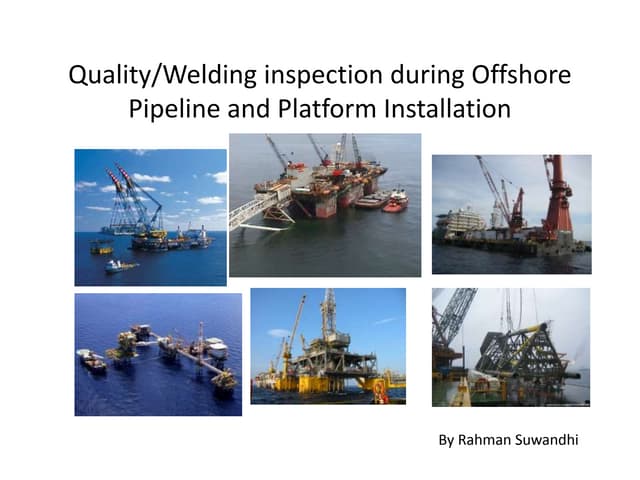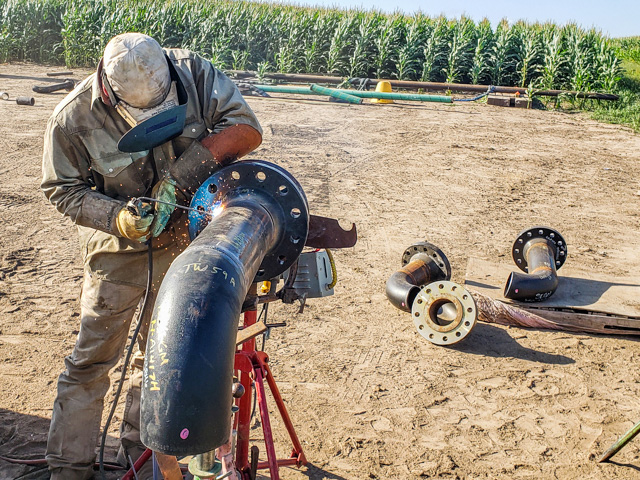Pipeline Welding Inspection: Essential Actions for Reliable Pipeline Building
Wiki Article
Advanced Techniques in Pipeline Welding Inspection: Developments and Technologies for Boosted Precision and Reliability in Weld Assessment
The landscape of pipeline welding evaluation is undertaking a substantial change, driven by sophisticated methods that promise to enhance both precision and dependability in weld evaluations. Advancements such as automated evaluation systems and progressed imaging technologies are redefining conventional techniques, while non-destructive testing approaches ensure product honesty is preserved.
Value of Weld Evaluation
Guaranteeing the honesty of pipe welds is essential to the overall safety and integrity of industrial systems. Welds act as the structural foundation of pipelines, which carry a selection of fluids under differing pressures. Problems in welding can bring about disastrous failures, causing not only substantial financial losses but additionally potential environmental catastrophes and hazards to public security. As a result, strenuous inspection of welds is essential to the lifecycle of pipeline facilities.The significance of weld evaluation expands beyond mere conformity with regulative standards. It works as a proactive procedure to recognize and fix blemishes, such as incomplete combination, porosity, or fractures, before they intensify into serious concerns. Efficient assessment techniques likewise add to the longevity of pipes, decreasing upkeep costs and enhancing functional efficiency.
Additionally, comprehensive weld examinations foster trust fund amongst stakeholders, including regulatory bodies, investors, and the communities offered by these pipelines. By making sure that all welds fulfill the called for standards, organizations can alleviate dangers and support their reputations. In summary, weld assessment is essential not just for operational integrity however also for the broader ramifications it holds for safety and security and environmental stewardship.
Automated Assessment Equipments
The combination of computerized assessment systems in pipeline welding has actually transformed the approach to making certain weld quality and integrity. These systems utilize sophisticated robotics and artificial intelligence to conduct inspections that are not only quicker but also much more consistent than standard techniques. Automated systems can cover comprehensive lengths of pipelines effectively, capturing information that human examiners might forget as a result of exhaustion or environmental problems.One of the vital advantages of automatic inspection systems is their capability to operate in hazardous atmospheres, minimizing the risk to human inspectors. They make use of different non-destructive testing (NDT) methods, such as ultrasonic testing and magnetic particle assessment, to examine weld stability without endangering the structure. The data accumulated is processed in real-time, allowing for instant feedback and prompt restorative actions when problems are determined.
Additionally, automated systems facilitate the standardization of evaluation procedures, ensuring that each weld is assessed versus consistent criteria. This not only boosts the integrity of results yet likewise simplifies conformity with governing standards. As markets proceed to prioritize safety and security and operational performance, the function of automatic inspection systems in pipeline welding will undoubtedly broaden, paving the means for more advanced high quality guarantee approaches.
Advanced Imaging Technologies
Frequently utilized in modern-day pipeline welding inspections, advanced imaging technologies have dramatically enhanced the ability to find and evaluate weld flaws. Methods such as electronic radiography, calculated tomography, and thermographic imaging provide examiners with high-resolution images that reveal sub-surface imperfections and architectural inconsistencies that may be undetectable to the naked eye.Digital radiography utilizes digital sensing units to catch images, enabling instant review and enhanced image contrast. This leads to quicker examinations and enhanced precision in recognizing essential defects. Calculated tomography, on the other hand, uses three-dimensional imaging, enabling examiners to envision complicated geometries and examine the integrity of welds from numerous angles - Pipeline Welding Inspection. This depth of evaluation is indispensable for detecting problems that conventional techniques may ignore.
Thermographic imaging utilizes infrared innovation to find variations in temperature, determining areas of potential weakness or stress within the weld. These sophisticated imaging technologies not only enhance issue discovery prices yet also reduce the moment and resources needed for pipe evaluations. Therefore, they play an important function in preserving pipeline safety and security and reliability, making certain conformity with sector requirements while minimizing functional dangers.
Non-Destructive Examining Techniques
Using numerous techniques, non-destructive testing (NDT) approaches are vital in pipeline welding assessments, permitting the examination of weld honesty without jeopardizing the product's structural stability. NDT includes a series of approaches, including ultrasonic testing (UT), radiographic screening (RT), magnetic bit testing (MT), and dye penetrant screening (PT) Each method has unique advantages and applications depending upon the details demands of the evaluation.
Ultrasonic screening makes use of high-frequency acoustic waves to find inner flaws, supplying accurate measurements of weld thickness and stability. Pipeline Welding Inspection. Radiographic screening employs X-rays or gamma rays to generate photos of the weld, disclosing interior defects that might not show up externally. Magnetic particle screening works for identifying surface area and near-surface suspensions in ferromagnetic materials, while dye penetrant screening highlights surface area cracks by making use of a colored color
Incorporating these NDT approaches right into pipe welding inspections boosts the precision and integrity of weld evaluations, guaranteeing that potential failures are determined early. As markets demand higher requirements for safety and security and performance, the duty of NDT in keeping the integrity of welded structures remains to be crucial in pipeline useful site construction and maintenance.

Future Fads in Weld Evaluation
As we seek to the future of weld assessment, developments in technology are poised to revolutionize the approaches used for assessing pipeline integrity. The assimilation of expert system (AI) and machine knowing in inspection procedures is anticipated to enhance the precision of defect discovery and predictive upkeep. These technologies permit for real-time information evaluation, making it possible for assessors to identify potential concerns before they intensify into substantial troubles.In addition, the usage of drones outfitted with innovative imaging systems is obtaining grip. These airborne assessments can cover large locations quickly, recording high-resolution photos and data that can be assessed for defects in hard-to-reach locations. This not only boosts safety yet additionally raises performance in the inspection process.
In addition, the growth of smart sensors installed in pipeline systems provides the capacity for continual surveillance. These sensors can spot modifications in stress, temperature, and vibrations, providing beneficial understandings into the wellness of the welds gradually.

Verdict
In verdict, the integration of sophisticated methods in pipeline welding assessment dramatically improves the accuracy and integrity of weld evaluations. Developments such as automatic evaluation systems, advanced imaging technologies, and non-destructive screening approaches play a vital function in improving flaw discovery rates and fostering positive maintenance strategies. As these innovations continue to develop, they will certainly even more ensure the safety and security and efficiency of pipeline systems, inevitably adding to the stability of critical framework.you can try these out

Report this wiki page